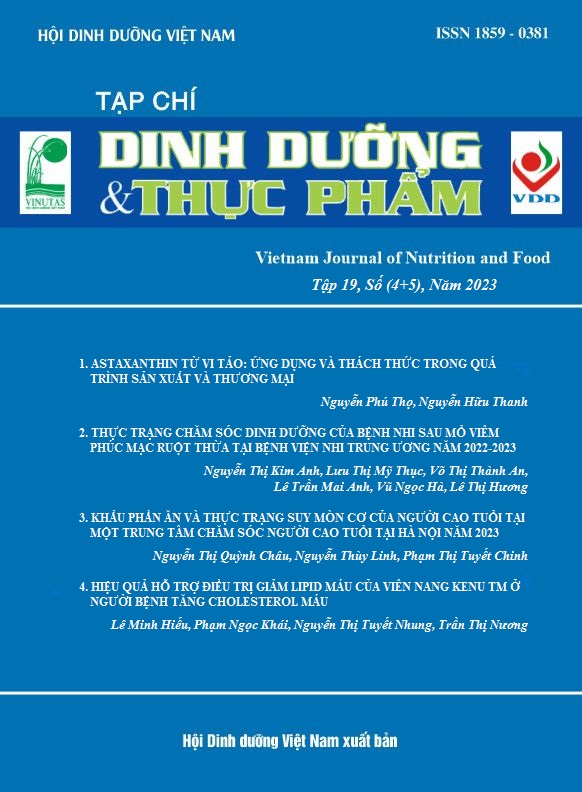THỰC HÀNH NUÔI DƯỠNG TRẺ 6-23 THÁNG TUỔI CỦA BÀ MẸ ĐƯA CON ĐẾN PHÒNG KHÁM - TƯ VẤN DINH DƯỠNG VÀ TIÊM CHỦNG, VIỆN ĐÀO TẠO Y HỌC DỰ PHÒNG VÀ Y TẾ CÔNG CỘNG
Nội dung chính của bài viết
Tóm tắt
Mục tiêu: Mô tả thực hành nuôi dưỡng trẻ 6-23 tháng tuổi của bà mẹ đưa con đến Phòng khám - tư vấn dinh dưỡng và tiêm chủng, Viện Đào tạo Y học dự phòng và Y tế công cộng năm 2022-2023.
Phương pháp: Đây là một nghiên cứu mô tả cắt ngang, dữ liệu về thực hành nuôi dưỡng được thu thập từ 394 cặp bà mẹ và con của họ trong độ tuổi 6-23 tháng tuổi đến khám - tư vấn và tiêm chủng tại phòng khám trong thời gian từ tháng 1/2022 đến tháng 3/2023.
Kết quả: Tỷ lệ trẻ đang được bú mẹ là 31% và có sự khác biệt giữa các nhóm tuổi (p<0,001); Có sự khác biệt có ý nghĩa thống kê về số bữa ăn giữa các nhóm tuổi (p<0,001); Trẻ sử dụng đa dạng các nhóm thực phẩm như lương thực, sữa, nhóm trái cây rau củ khác và chất béo, tỷ lệ sử dụng bánh kẹo ngọt 43,9%; tỷ lệ sử dụng gia vị 62,4%.
Kết luận: Tỷ lệ trẻ đang được bú mẹ còn thấp, nhiều trẻ bú mẹ bằng bình có núm vú,trẻ ít được sử đụng da dạng nhóm thực phẩm như trứng, thịt, các loại hạt họ đậu.
Từ khóa
Thực hành nuôi dưỡng, trẻ 6-23 tháng tuổi
Chi tiết bài viết
Tài liệu tham khảo
2.Viện Dinh dưỡng quốc gia -BộY tếvà Tổng cục Thống kê. Tổng điều tra dinh dưỡng 2019 -2020. Trung tâm giáo dục truyền thông dinh dưỡng, 2021.
3.World Health Organization and U. N. C. Fund (UNICEF). Global Strategy for Infant and Young Child Feeding.World Health Organization, 2003. Access: 20May,2023. [Online]. Available at: https://apps.who.int/iris/handle/10665/42590
4.Unicef for every child, Tổng cục Thống kê, và United Nations Population Fund. Điều tra các mục tiêu phát triển bền vững vềtrẻem và phụnữViệtNam 2020 -2021. tháng 12/2021.
5.Lê Bạch Mai, Lê Danh Tuyên, và ĐỗThịPhương Hà, Các phương pháp điều tra và đánh giá khẩu phần. NxbY học, Hà Nội. 2017.
6.World Health Organization and Unicef for every child. Indicators for assessing infant and young child feeding practices. WHO Document Production Services, 2021.
7.Unicef for every child and World Health Organization. Global Breastfeeding Scorecard 2021: Protecting Breastfeeding Through Bold National Actions During The Covid-19 Pandemic And Beyond.2021. [Online]. Available at: unicef.org/breastfeeding
8.UNICEF Press Centre | UNICEF calls for the narrowing of „breastfeeding gaps‟ between rich and poor worldwideUNICEF Europe andCentral Asia. https://www.unicef.org/eca/press-releases/unicef-calls-narrowing-breastfeeding-gaps-between-rich-and-poor-worldwide (Access6/20/2023).
9.E. Asimaki, M. Dagla,A. Sarantaki, and M. Iliadou. Main Biopsychosocial Factors Influencing Breastfeeding: a SystematicReview, Maedica (Bucur) 2022; 17(4):955–962. doi: 10.26574/maedica.2022.17.4.955.
10.Unicef for every child. Improving Young Children‟s Diets During the Complementary Feeding Period.Unicef for every child, 2020.
11.ChaithaweesupP, BoonrusmeeS, JaruratanasirikulS, PuwanantM, Chimrung,Kand SriplungH. Infant and Child Feeding Index (ICFI) and NutritionalAssessment in 6-12-Month-Old Infants: A Study inSouthern Thailand.2022, DOI: 10.15226/jfs.2022.001190.
12.Champion C and SeidelR. Engaging the Private Sectorto Improve Access to Fortified Complementary Foods: Moving from the „If‟ to the „How‟”, 2015.
13.KhandpurNet al. Ultra-Processed Food Consumption among the Paediatric Population: An Overview and Call to Action from the European Childhood Obesity Group. ANM. 2020;76(2):109–113.doi: 10.1159/000507840.
14.World Health Organization. Regional Office for Europe. Commercial foods for infants and young children in the WHO European Region: a study of the availability, composition and marketing of baby foods in four European countries. World Health Organization. Regional Office for Europe, WHO/EURO:2019-3588-43347-60811, 2019. Access: 4/08/2023. [Online]. Available at: https://apps.who.int/iris/handle/10665/346581
Các bài báo tương tự
- Nguyễn Trọng Hưng, Nguyễn Thị Thuý Hiền, Đặng Khánh Linh, Nguyễn Thị Thảo, Lê Hoàng Duy Nam, Hoàng Khắc Tuấn Anh, Vũ Hoài Thu, Tạ Thuỳ Linh, Phan Hướng Dương, Phan Hoàng Hiệp, TÌNH TRẠNG DINH DƯỠNG CỦA NGƯỜI BỆNH ĐÁI THÁO ĐƯỜNG TÝP 2 TẠI BỆNH VIỆN NỘI TIẾT TRUNG ƯƠNG GIAI ĐOẠN 2015-2025 VÀ MỘT SỐ YẾU TỐ LIÊN QUAN: TỔNG QUAN VÀ LUẬN ĐIỂM , Tạp chí Dinh dưỡng và Thực phẩm: Tập 21 Số 6 (2025)
- Lê Thị Hương, Nguyễn Thị Đính, Dương Thị Phượng, Hoàng Hải My, Nguyễn Thị Thu Liễu, TÌNH TRẠNG DINH DƯỠNG CỦA BỆNH NHÂN ĐÁI THÁO ĐƯỜNG TÝP 2 VÀ MỘT SỐ YẾU TỐ LIÊN QUAN TẠI KHOA NỘI BỆNH VIỆN ĐẠI HỌC Y HÀ NỘI NĂM 2016 , Tạp chí Dinh dưỡng và Thực phẩm: Tập 13 Số 4 (2017)
- Mai Đại Đức Anh, Đồng Thị Phương, Vũ Thị Bích Nga, Vũ Thị Lan Phương, Nguyễn Thùy Linh, Nguyễn Hoàng Thiện Tâm, Nguyễn Trọng Hưng, CÁC YẾU TỐ LIÊN QUAN ĐẾN TÌNH TRẠNG DINH DƯỠNG Ở BỆNH NHÂN ĐÁI THÁO ĐƯỜNG TÝP 2 TẠI BỆNH VIỆN ĐẠI HỌC Y HÀ NỘI NĂM 2020 , Tạp chí Dinh dưỡng và Thực phẩm: Tập 19 Số 3E (2023)
Ông/Bà cũng có thể bắt đầu một tìm kiếm tương tự nâng cao cho bài báo này.


